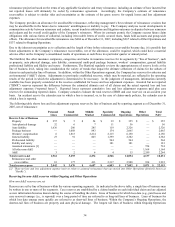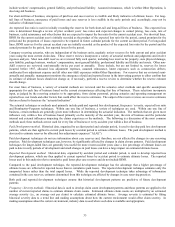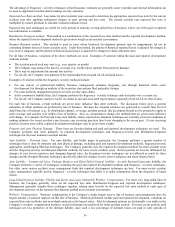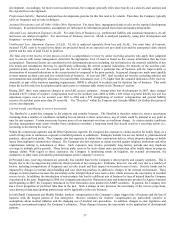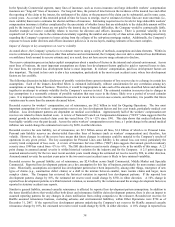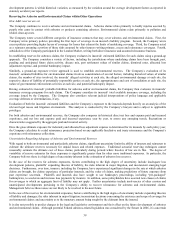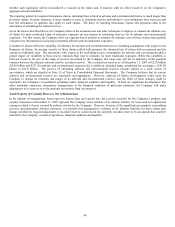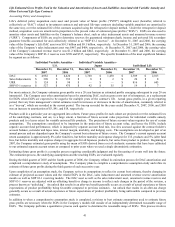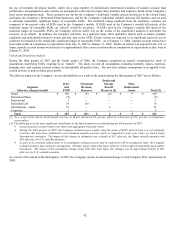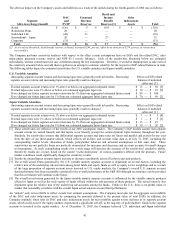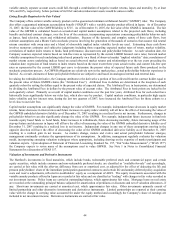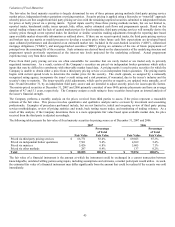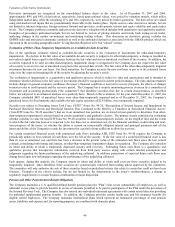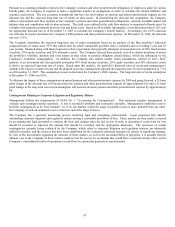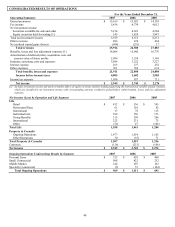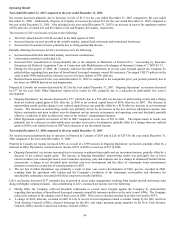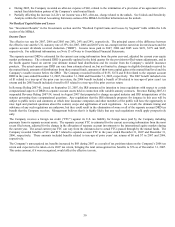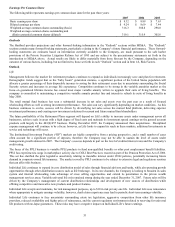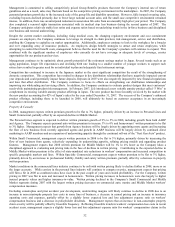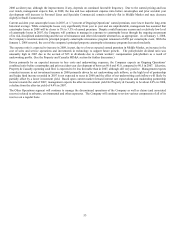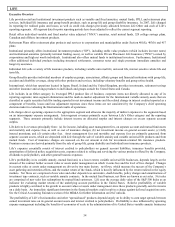The Hartford 2007 Annual Report Download - page 44
Download and view the complete annual report
Please find page 44 of the 2007 The Hartford annual report below. You can navigate through the pages in the report by either clicking on the pages listed below, or by using the keyword search tool below to find specific information within the annual report. 44
variable annuity separate account assets could fall, through a combination of negative market returns, lapses and mortality, by at least
54% and 69%, respectively, before portions of its DAC and sales inducement assets would be unrecoverable.
Living Benefits Required to be Fair Valued
The Company offers certain variable annuity products with a guaranteed minimum withdrawal benefit (“GMWB”) rider. The Company
also offers a guaranteed minimum accumulation benefit (“GMAB”) with a variable annuity product offered in Japan. As of December
31, 2007, the fair value of the GMWB liability is $715. As of December 31, 2007, the fair value of the GMAB is immaterial. The fair
value of the GMWB is calculated based on actuarial and capital market assumptions related to the projected cash flows, including
benefits and related contract charges, over the lives of the contracts, incorporating expectations concerning policyholder behavior such
as lapses, fund selection, resets and withdrawal utilization. Because of the dynamic and complex nature of these cash flows, best
estimate assumptions and a Monte Carlo stochastic process involving the generation of thousands of scenarios that assume risk neutral
returns consistent with swap rates and a blend of observable implied index volatility levels are used. Estimating these cash flows
involves numerous estimates and subjective judgments including those regarding expected market rates of return, market volatility,
correlations of market index returns to funds, fund performance, discount rates and policyholder behavior. At each valuation date, the
Company assumes expected returns based on risk-free rates as represented by the current LIBOR forward curve rates; forward market
volatility assumptions for each underlying index based primarily on a blend of observed market “implied volatility” data; correlations of
market returns across underlying indices based on actual observed market returns and relationships over the ten years preceding the
valuation date; regression of fund returns to index returns based on the most recent three years actual results; and current risk-free spot
rates as represented by the current LIBOR spot curve to determine the present value of expected future cash flows produced in the
stochastic projection process. As GMWB obligations are relatively new in the market place, actual policyholder behavior experience is
limited. As a result, estimates of future policyholder behavior are subjective and based on analogous internal and external data.
In valuing the embedded derivative, the Company attributes to the derivative a portion of fees collected from the contract holder equal to
the present value of future GMWB claims (the “Attributed Fees”). Attributed Fees in dollars are determined at the inception of each
quarterly cohort by setting the dollars equal to the present value of expected claims. The Attributed Fees, in basis points, are determined
by dividing the Attributed Fees in dollars by the present value of account value. The Attributed Fees in basis points are locked-in for
each quarterly cohort. Primarily as a result of capital market conditions over the past few years, Attributed Fees for each cohort have
historically been significantly below our rider fees, which also vary by product. Capital markets conditions, in particular high equity
index volatility and low interest rates, during the last two quarters of 2007, have increased the Attributed Fees for those cohorts to a
level close to our rider fees.
Capital market assumptions can significantly change the value of GMWB. For example, independent future decreases in equity market
returns, future decreases in interest rates and future increases in equity index volatility will all have the effect of increasing the value of
the GMWB embedded derivative liability as of December 31, 2007 resulting in a realized loss in net income. Furthermore, changes in
policyholder behavior can also significantly change the value of the GMWB. For example, independent future increases in fund mix
towards equity based funds vs. bond funds, future increases in withdrawals, future decreasing mortality, future increasing usage of the
step-up feature and decreases in lapses will all have the effect of increasing the value of the GMWB embedded derivative liability as of
December 31, 2007 resulting in a realized loss in net income. Independent changes in any one of these assumptions moving in the
opposite direction will have the effect of decreasing the value of the GMWB embedded derivative liability as of December 31, 2007
resulting in a realized gain in net income. As markets change, mature and evolve and actual policyholder behavior emerges,
management continually evaluates the appropriateness of its assumptions. In addition, management regularly evaluates the valuation
model, incorporating emerging valuation techniques where appropriate, including drawing on the expertise of market participants and
valuation experts. Upon adoption of Statement of Financial Accounting Standard No. 157, “Fair Value Measurements”, (“SFAS 157”)
the Company expects to revise many of the assumptions used to value GMWB. See Note 1 in Notes to Consolidated Financial
Statements for a discussion of SFAS 157.
Valuation of Investments and Derivative Instruments
The Hartford’ s investments in fixed maturities, which include bonds, redeemable preferred stock and commercial paper; and certain
equity securities, which include common and non-redeemable preferred stocks, are classified as “available-for-sale” and accordingly,
are carried at fair value with the after-tax difference from cost or amortized cost, as adjusted for the effect of deducting the life and
pension policyholders’ share of the immediate participation guaranteed contracts; and certain life and annuity deferred policy acquisition
costs and reserve adjustments, reflected in stockholders’ equity as a component of AOCI. The equity investments associated with the
variable annuity products offered in Japan are recorded at fair value and are classified as “trading” with changes in fair value recorded in
net investment income. Policy loans are carried at outstanding balance, which approximates fair value. Mortgage loans on real estate
are recorded at the outstanding principal balance adjusted for amortization of premiums or discounts and net of valuation allowances, if
any. Short-term investments are carried at amortized cost, which approximates fair value. Other investments primarily consist of
limited partnership and other alternative investments and derivatives instruments. Limited partnerships are reported at their carrying
value with the change in carrying value accounted for under the equity method and accordingly the Company’ s share of earnings are
included in net investment income. Derivatives instruments are carried at fair value.


